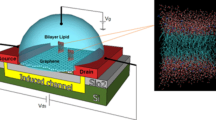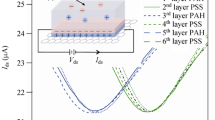Abstract
Graphene, a purely two-dimensional sheet of carbon atoms, as an attractive substrate for plasmonic nanoparticles is considered because of its transparency and atomically thin nature. Additionally, its large surface area and high conductivity make this novel material an exceptional surface for studying adsorbents of diverse organic macromolecules. Although there are plenty of experimental studies in this field, the lack of analytical model is felt deeply. Comprehensive study is done to provide more information on understanding of the interaction between graphene and DNA bases. The electrostatic variations occurring upon DNA hybridization on the surface of a graphene-based field-effect DNA biosensor is modeled theoretically and analytically. To start with modeling, a liquid field effect transistor (LGFET) structure is employed as a platform, and graphene charge density variations in the framework of linear Poisson– Boltzmann theories are studied under the impact induced by the adsorption of different values of DNA concentration on its surface. At last, the artificial neural network is used for improving the curve fitting by adjusting the parameters of the proposed analytical model.








Similar content being viewed by others
References
Abadi HKF et al (2014) Development of carbon nanotube based biosensors model for detection of single-nucleotide polymorphism. Sci Adv Mater 6(3):513–519
Polyushkin DK et al (2013) Graphene as a substrate for plasmonic nanoparticles. J Opt 15(11):114001
Driscoll T et al (2009) Memory metamaterials. Science 325(5947):1518–1521
Huang K-J et al (2011) An electrochemical amperometric immunobiosensor for label-free detection of α-fetoprotein based on amine-functionalized graphene and gold nanoparticles modified carbon ionic liquid electrode. J Electroanal Chem 656(1):72–77
Kuzyk A et al (2014) Reconfigurable 3D plasmonic metamolecules. Nat Mater 13(9):862–866
MacDonald KF et al (2009) Ultrafast active plasmonics. Nat Photonics 3(1):55–58
Zhang S et al (2012) Photoinduced handedness switching in terahertz chiral metamolecules. Nat Commun 3:942
Zheng YB et al (2009) Active molecular plasmonics: controlling plasmon resonances with molecular switches. Nano Lett 9(2):819–825
De Gendt S (2013) Graphene devices. In: 223rd ECS Meeting (May 12–17, 2013). Ecs.
Datta SS et al (2008) Crystallographic etching of few-layer graphene. Nano Lett 8(7):1912–1915
Schwierz F (2010) Graphene transistors. Nat Nanotechnol 5(7):487–496
Nourbakhsh A et al (2013) (Invited) Toward ambient-stable molecular gated graphene-FET: a donor/acceptor hybrid architecture to achieve bandgap in bilayer graphene. ECS Trans 53(1):121–129
Dong X et al (2010) Electrical detection of DNA hybridization with single-base specificity using transistors based on CVD-grown graphene sheets. Adv Mater 22(14):1649–1653
Abouzar MH et al (2012) Label-free electrical detection of DNA by means of field-effect nanoplate capacitors: Experiments and modeling. Phys Status Solidi A 209(5):925–934
Drummond TG, Hill MG, Barton JK (2003) Electrochemical DNA sensors. Nat Biotechnol 21(10):1192–1199
Karimi H, Yusof R, Rahmani R, Ahmadi MT (2013) Optimization of DNA sensor model based nanostructured graphene using particle swarm optimization technique. J Nanomater. doi:10.1155/2013/789454
Fu D, Li LJ (2010) Label-free electrical detection of DNA hybridization using carbon nanotubes and graphene. Nano Rev 1(0)
Gooding JJ (2002) Electrochemical DNA hybridization biosensors. Electroanalysis 14(17):1149–1156
Varghese N et al (2009) Binding of DNA nucleobases and nucleosides with graphene. ChemPhysChem 10(1):206–210
Shin JK et al (2004) Detection of DNA and protein molecules using an FET-type biosensor with gold as a gate metal. Electroanalysis 16(22):1912–1918
Lee SJ et al (2008) ssDNA aptamer-based surface plasmon resonance biosensor for the detection of retinol binding protein 4 for the early diagnosis of type 2 diabetes. Anal Chem 80(8):2867–2873
Ang PK et al (2008) Solution-gated epitaxial graphene as pH sensor. J Am Chem Soc 130(44):14392–14393
Karimi H et al (2014) Development of solution-gated graphene transistor model for biosensors. Nanoscale Res Lett 9(1):1–11
Karimi H et al (2014) Analytical development and optimization of a graphene–solution interface capacitance model. Beilstein J Nanotechnol 5(1):603–609
Dong X et al (2010) Electrical detection of DNA hybridization with single-base specificity using transistors based on CVD-grown graphene sheets. Adv Mater 22(14):1649
Shinwari W et al (2007) Modeling and simulation of electrochemical DNA biosensors in CMOS technology. McMaster University
Ahmadi MT et al (2009) MOSFET-like carbon nanotube field effect transistor model. In: 2009 NSTI Nanotechnology Conference (Nanotech 2009), Houston, USA
Avouris P, Chen Z, Perebeinos V (2007) Carbon-based electronics. Nat Nanotechnol 2(10):605–615
Lemme MC et al (2007) A graphene field-effect device. arXiv preprint cond-mat/0703208
Allen BL, Kichambare PD, Star A (2007) Carbon nanotube field-effect-transistor-based biosensors. Adv Mater 19(11):1439–1451
Cherstvy A (2013) Detection of DNA hybridization by field-effect DNA-based biosensors: mechanisms of signal generation and open questions. Biosens Bioelectron 46:162–170
Sarle WS (1994) Neural networks and statistical models
Quah JT, Thwin MMT (2002) Prediction of software readiness using neural network. In: Proceedings of 1st International Conference on Information Technology & Applications
Rahmani R et al (2014) Static VAR compensator using recurrent neural network. Electr Eng 96(2):109–119
Passlack M (2008) III-V metal-oxide-semiconductor technology. 2008 I.E. 20th International Conference on Indium Phosphide and Related Materials (IPRM), p. 59–59
Achuthan M, Bhat MAK (2006) Fundamentals of semiconductor devices. Tata McGraw-Hill
Ahmadi MT et al (2010) Carbon nanotube conductance model in parabolic band structure. IEEE.
Karimi F et al (2012) Analytical modeling of graphene-based DNA sensor. Sci Adv Mater 4(11):1142–1147
Polash B, Huq HF (2008) Analytical model of carbon nanotube field effect transistors for NEMS applications. 2008 51st Midwest Symposium on Circuits and Systems, Vols 1 and 2, p. 61–64
Ahmadi MT et al (2009) Numerical study of fermi energy for P-type silicon nanowire. Nanosci Nanotechnol 1136:98–102
Karamdel J et al (2008) Formulation and Simulation for Electrical Properties of a (5,3) Single Wall Carbon Nanotube. ICSE: 2008 I.E. International Conference on Semiconductor Electronics, Proceedings, p. 545–548
Acknowledgments
The authors would like to acknowledge the financial support from the Research University grant of the Ministry of Higher Education (MOHE), Malaysia, under project vot number: 4J011. Also thanks to the Research Management Centre (RMC) of Universiti Teknologi Malaysia (UTM) for providing an excellent research environment in which to complete this work.
Author information
Authors and Affiliations
Corresponding author
Rights and permissions
About this article
Cite this article
Karimi, H., Rahmani, R., Othman, M.F. et al. An Analytical Approach to Calculate the Charge Density of Biofunctionalized Graphene Layer Enhanced by Artificial Neural Networks. Plasmonics 11, 95–102 (2016). https://doi.org/10.1007/s11468-015-9998-y
Received:
Accepted:
Published:
Issue Date:
DOI: https://doi.org/10.1007/s11468-015-9998-y




